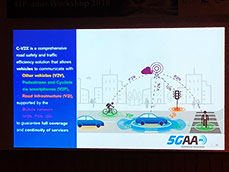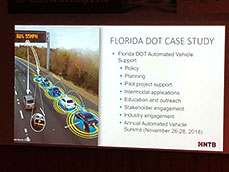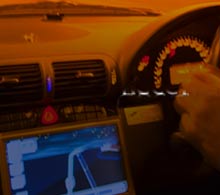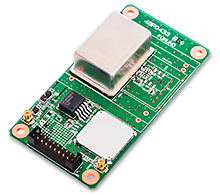Articles for ITS market New proposal for Private Car Automated Driving Level and other Hot 5G Technology Topics
National project ”SIP”: Final year of the first period. Next generation automated driving in the second period.
In mid-November, 2018 many governments, local governments, companies, and academic people involved in automated driving from all over the world gathered in Odaiba, Tokyo, Japan.
Everyone gathered to discuss the national SIP (Cross-ministerial Strategic Innovation Promotion Program) project which related ministries and agencies in Japan worked together on regarding the next generation of technology development. The project relates to automated automobile driving is available as along with healthcare and chemistry. As part of the project, workshops are held in Tokyo every year.
SIP is held for a 5 year period with this year being the final year of the first phase. In the automated driving workshop, a comprehensive discussion was held on various verification tests and mass production projects. This included various automated driving that has been conducted in various parts of the world over the past 5 years.
For Japan, during the Tokyo Olympics and Paralympic Games in 2020, a large-scale plan that is considered a showcase for the next-generation automated driving in the Tokyo bay area, mainly in Odaiba will be implemented. This will be implemented as part of the second phase of SIP, called post SIP.
In the past five years I have covered the SIP workshop every year. I communicated with government officials in England and Sweden that I met throughout the years, while covered the field of automated driving demonstration tests for both countries.
In this workshop, which was the 1st SIP Final Year, we deepened friendships with the stakeholders and discussed full-scale operation of automated driving in various parts of the world.
Discussion of ODD (Operational Design Domain) and Level 4 for private car
 Explanation of experiments of automated driving in rural areas conducted in Japan.
Explanation of experiments of automated driving in rural areas conducted in Japan.
 Conceptual diagram of automated driving level by SIP automated driving project.
Conceptual diagram of automated driving level by SIP automated driving project.
Among those discussions, the most important issue was interpretation of ODD.
“ODD” is an abbreviation for Operational Design Domain. It is a condition for automated driving function. For example when referring to an entire area including city centers, regional cities, mountainous areas, etc., and also refers to road conditions such as highways and narrow streets of the city. There are various Japanese translations, but it is often called “operation design area”.
The foundation of the idea of ODD was established in September 2016 when the Society of Automotive Engineers in US (SAE) and the National Highway Traffic Safety Association (NHTSA) unified the guidelines for automated driving levels.
Among the automated driving levels, Level 3 is the point where interpretation of ODD is particularly necessary. At level 3, responsibility for driving is shifted from vehicle driver up to level 2 of the vehicle system. However, unlike full automated driving at level 3 or higher, level 3 may also be driven by the driver depending on the situation. Specifically, when the driver becomes drowsy while traveling on a highway. The driver would press the automated driving changeover button to switch to the automated driving mode. However, if an accident occurs during the automated driving the traffic control police officer will switch off all automated driving in the area and the vehicle system cannot continue automated driving, instructing the driver to take control of the vehicle.
These ODD corresponding conditions such as accidents, etc. are pre-programmed in advance. Because so many different conditions are possible, it is extremely difficult to deal with all driving situations at level 3. Therefore traveling at level 3 is only possible in limited driving conditions when using ODD.
Another new way of thinking regarding private car driving was devised by SIP and introduced in this workshop. According to the conventional way of thinking, private cars correspond to level 0 to level 2, which is manual driving and considered ODD for level 3. On the other hand level 4 and 5 are targeted for mobility services such as public transportation.
In addition to these ideas the level of automated driving functions for private cars is gradually upgraded and raise from level 0 to level 4. There are also private cars being developed that will correspond to Level 4 when produced. In short the level of automated driving is still in the early stages. Advancements for automated driving vehicle mass-production continue grow. Private automated driving vehicles and mobility services demand may increase which would possibly lead to dramatic changes in the international discussions.
Attention also attracts new technologies such as 5G
In parallel with the discussion on the automated driving level, the attention of SIP workshop participants was also high about the fifth generation communication system (5G).
Because of the extreme increase of the 5G communication speed and data amount, the time delay of exchanging data between the communication devices is reduced. It is expected that conveniences such as communication between vehicles (V2V) and communication between a vehicle and a smartphone carried by pedestrians (V2P), which is important for automated driving safety will also increase.
The lecture by the US Department of Transportation (DOT) touched on the relationship between 5 G and automated driving as shown in the demonstration case of V2V in Florida (USA).
Also in Japan the second phase of SIP, a verification test on V2X, which is a collective term for communication between vehicles utilizing 5G and outside is planned.
However, concerning the contents of such a verification test there is concern there were no specific remarks from the country or the automobile manufacturer.
The first phase of the SIP automated driving project will end on March 31, 2020. The summer of 2020 where the Tokyo Olympic Games and the Paralympic Games are being held is the second phase of SIP. Based on the results of the first phase of SIP we strongly hope that the roadmap of SIP 2 will be released domestically and overseas as soon as possible.
Writer introduction

Mr. Kenji Momota Automotive journalist
His major is the world automotive industry and he is also familiar with the energy industry, IT and the aging society problem as the related fields. He acts around the world based in Japan and USA and writes for the general magazines, the technology journals and the automotive related media etc.
He is also commentator of motor race and world's motor show on TV program based on his career of the driver of Indy Racing League and NASCAR. In recent years, he has been covering about a paradigm shift from developed countries to developing countries, the motorized vehicle like EV and the telematics.
FURUNO ITS Journal
Click here for the latest articles after 2022 (in Japanese)2022
- The "realistic" self-driving roadmap shown by the Japanese government and a hands-on report on the latest Subaru EyeSight X
- Will FCVs (Fuel Cell Vehicles) Become Popular? ~New Movement in Toyota and Honda~
- The 'Complete' online sales of new cars start in Japan. Will this new way of buying cars take root?
- Many Firsts! On-Site Report from Tokyo Auto Salon 2022 - The author, who knows what goes on behind the scenes, looks back on 40 years of history. -
2021
- "Moving toward zero traffic fatalities for four-wheeled and two-wheeled vehicles globally in 2050" ~Experience on Honda's latest safety technologies~
- Tsuneishi Shipbuilding's building and DX, an exclusive visit to the main factory
- Japan's Smart City: New Moves toward Practical Use
- When will self-driving buses (service cars) be put to "full-scale" practical use?
- Utilization vehicle data during disasters
- Toyota-led Connected Technology to Transform Commercial Vehicle Business -From light trucks to large trucks and buses-
- Toyota enters the connected car "Personalization" business
- Japanese automakers' carbon-neutral strategies swept up in ESG investment
- Drive experience of the latest autonomous vehicle models and advanced driving support systems
- Will carbon neutrality accelerate the trend to strengthen LCA (Life Cycle Assessment)?
- Semiconductor shortage exposes realities of the automotive industry
- Online Autonomous Driving Contest Enhancing development of Human Resources
2020
- What happens to CASE when gas cars are banned in Japan?
- When will Flying Cars be launched?
- Expectation vs. reality:Autonomous Driving in Japan
- V2X, Becoming increasingly important in autonomous driving
- Technology of Subaru “EyeSight X”
- Lifestyle-oriented French cars gain popularity in Japan
- Human-oriented smart cities are wanted
- MaaS and CASE, how would automotive industry change after COVID-19?
- The beginning of virtualization era, triggered by COVID-19
- Trend of EV shift and consumer demands
- TOYOTA Press conference about ADAS - Releasing algorithm for "sudden acceleration suppression during attempted sudden acceleration" free of charge -
- The Japanese automotive industry in 2020 - 3 turning points -
- "Using a smartphone while driving" and "Level 3 automated driving"
2019
- Motor show business model is at a turning point - Tokyo Motor Show Report -
- Commercialization and monetization of MaaS - ITS World Congress Singapore Report -
- Android Automotive pays attention to V2X - Report from the Frankfurt Motor Show 2019 in Germany -
- Automobile Distribution Revolution and DCM (Data Communication Module)
- Connected business potential and newly proposed "eMaaS" by Honda
- 5G services for practical use are multiplying
- Connectivity technologies attracting attention due to frequent traffic accidents
- Shanghai Motor Show report -SUV, EV, Automated car & 5G-
- Drone Business roadmap and updates to Michibiki (Quasi-Zenith Satellite System)
- MaaS (Mobility as a Service) "town development." Full-scale promotion for a national project
- CES organizer states "Data Period in 2020s." Transformation of the Automotive Industry in CES, US "-CES2019 Report-"
- "Return to Origin" directed towards the age of change, automatic operation and connectivity
2018
- New proposal for Private Car Automated Driving Level and other Hot 5G Technology Topics
- Standardized EV charging infrastructure concerns in Europe, US, Japan and China - Kobe EVS 31 field report -
- Touring a pure car carrier and a test drive of the latest hybrid car
- Planning stage products are exhibited at the newly established visualized mobility service "TOYOTA MOBILITY SHOWROOM".
- Potential “Community Car-share” program promoted by local residents
- CES Asia Report 2108
- Companies attempt new Vehicle-to-Infrastructure communications, including traffic volume measurements and vehicle positioning. -ITS Asia Pacific Forum in Fukuoka-
- Geneva show in Switzerland. Flying cars and MaaS (Mobility as a Service) were hot topics.
- EV (Electric Vehicle) proposals by country
- MaaS competition through service mobilization, M & A and technical field collaboration is accelerating. - The CES 2018 Report -
2017
- Big data’s initiative and fight for the automotive industry. Cooperation among companies becomes increasingly important.
- Connected car and road-to-vehicle communication automatic operation
- ETC (Electronic Toll Collection) and ETC2.0. Current situation and projected future
- Rapid development of sharing economy
- Germany is first to recognize level 3 automated driving
- ITS EU 2017 Field Reports -Automatic Operation and the eCall-
- From Infotainment to ITS, the competitive area is spreading in the car big data industry.
- GTC (GPU Technology Conference) Report and the de facto standardization of AI (artificial intelligence)
- Renesas' new challenge! "e-AI Solution" and "Renesas Autonomy"
- The Automobile industry is shifting from a manufacturing industry to a service industry.
- The movement toward accident countermeasures for aging drivers in Japan
- Fusion of ride sharing and fully automated driving is advancing in the USA.
2016
- Overview of the Quasi-Zenith Satellite System (QZSS) and advancements toward full-scale practical use including the Tokyo Olympic Games - G-space EXPO 2016 report-
- Japan’s automated driving project "SIP-adus" will be a large demonstration experiment.
- The International Home Care & Rehabilitation Exhibition. There were many car manufactures with exhibits booths at this show.
- Japanese car manufacturers starting to concentrate on strengthening the ADAS system
- A new movement of legislation for autonomous cars
- Cyber Security and “AGL”, the new OS for automotive are hot topics in the connected car industry
- “High precision 3D map” the key future of autonomous car and pedestrian dead reckoning
- Chinese “BAT” is accelerating their business in the EV (Electric Vehicle) market
- Tesla's original connection to Taiwan and the new transportation system technologies.
- "The main topic" of the Geneva Motor Show was how to strengthen "pedestrian protection"
- The probe data business is getting more competitive
- Reporting directly from the 2016 CES show "Data services will soon become the main revenue source of automotive industry"
2015
- Do the automated driving systems need the GNSS (Global Navigation Satellite System) ?
- ETC Version 2.0 is coming soon. A new service was announced at the Tokyo Motor Show and the possibility that is could be used as a device for older drivers.
- "Connected Horizon" and "eHorizon". Germany's leading parts supplier accelerates strengthening of "Big Data" for business



 SIP-adus Workshop 2018
SIP-adus Workshop 2018 Lecture at SIP workshop
Lecture at SIP workshop Conceptual diagram of level 4 thinking by private car.
Conceptual diagram of level 4 thinking by private car. Conceptual Diagram for 5G Practical Use
Conceptual Diagram for 5G Practical Use  Conceptual Diagram for V2V in Florida, US
Conceptual Diagram for V2V in Florida, US GPS/GNSS Receiver&Chips and Modules (positioning and timing)
GPS/GNSS Receiver&Chips and Modules (positioning and timing)